Lifehouse Method
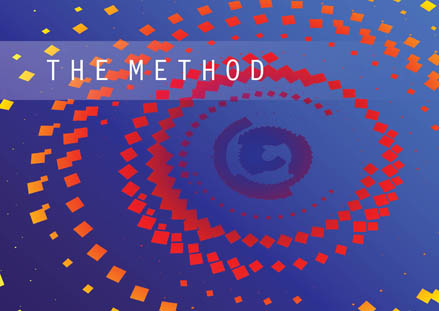 The Lifehouse Method was a software system that Pete Townshend launched in 2007, designed to generate unique pieces of music processed from various personal data that a user input into the website interface. The songs generated by the system were considered to be authentic musical “portraits” of the “sitters” who took part in the Method experiment. The concept of the Lifehouse Method grew out of Pete Townshend’s 1971 Lifehouse story, which provided the inspiration and backing tracks to such masterpieces as The Who’s Baba O’Riley, and other classics that were featured on Who's Next. Pete's ultimate vision in the Lifehouse was to bring a large group of people together in a celebration concert to listen to music that was uniquely composed for each individual, with a grande finale that combined all the pieces together. Pete explored this idea further in "The Boy Who Heard Music", an internet novella that was published on his blog in 2005. Soon after, Pete’s vision finally became a reality, and the Lifehouse Method was created by mathematician and composer Lawrence Ball and software engineer Dave Snowdon, who worked closely with Pete throughout the design and development of this unique and groundbreaking musical portraiture system.
The Lifehouse Method was a software system that Pete Townshend launched in 2007, designed to generate unique pieces of music processed from various personal data that a user input into the website interface. The songs generated by the system were considered to be authentic musical “portraits” of the “sitters” who took part in the Method experiment. The concept of the Lifehouse Method grew out of Pete Townshend’s 1971 Lifehouse story, which provided the inspiration and backing tracks to such masterpieces as The Who’s Baba O’Riley, and other classics that were featured on Who's Next. Pete's ultimate vision in the Lifehouse was to bring a large group of people together in a celebration concert to listen to music that was uniquely composed for each individual, with a grande finale that combined all the pieces together. Pete explored this idea further in "The Boy Who Heard Music", an internet novella that was published on his blog in 2005. Soon after, Pete’s vision finally became a reality, and the Lifehouse Method was created by mathematician and composer Lawrence Ball and software engineer Dave Snowdon, who worked closely with Pete throughout the design and development of this unique and groundbreaking musical portraiture system.
The lifehouse-method.com website launched on April 25, 2007, and over a 15 month period generated around 10,500 musical portraits before it was closed in 2008. In 2012, Lawrence Ball released Method Music, an album of elaborated music created for the Lifehouse Method project. The album contains a track called Meher Baba Piece that Pete used as a basis for his song Fragments that was included in The Who’s 2006 Endless Wire album. To date, the Lifehouse Method concert for sitters to gather and celebrate a performance of their portraits has not yet taken place.

The following is the history of the Lifehouse Method and the Method Music album, told primarily in Pete’s own words sourced from various articles, liner notes and transcripts from Method events, followed by exclusive interviews with Lawrence Ball, Dave Snowdon, studio engineer Myles Clarke, and graphic designer Richard Evans.
Lifehouse
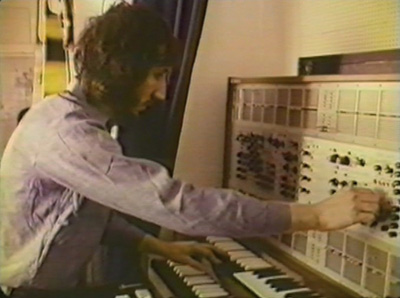 "Baba O'Riley was a number I wrote while I was doing these experiments with tapes on the synthesizer. Among my plans for the concert and film of the concert at the Young Vic was to take a person out of the audience and feed information – height, weight, astrological details, beliefs and behaviour etc – about that person into the synthesizer. The synthesizer would then select notes from the pattern of that person. It would be like translating a person into music. On this particular track I programmed details about the life of Meher Baba and that provides the backing for the number." Pete Townshend - NME - August 21, 1971
"Baba O'Riley was a number I wrote while I was doing these experiments with tapes on the synthesizer. Among my plans for the concert and film of the concert at the Young Vic was to take a person out of the audience and feed information – height, weight, astrological details, beliefs and behaviour etc – about that person into the synthesizer. The synthesizer would then select notes from the pattern of that person. It would be like translating a person into music. On this particular track I programmed details about the life of Meher Baba and that provides the backing for the number." Pete Townshend - NME - August 21, 1971
"In 1971 I wrote a film script of Lifehouse for Universal Pictures. It was never realised as a film or any kind of theatrical narrative drama until 1999, when it was developed by my company Eel Pie and broadcast as a radio play by the BBC. Many of the songs intended for the Lifehouse project as originally configured are of course familiar to listeners as staples of rock radio, television, and more: Baba O’Riley, Won’t Get Fooled Again, Behind Blue Eyes, The Song Is Over, and many more were all part of what was to be Lifehouse.
"The idea of Lifehouse originally centred on an idea about a self-sufficient drop-out family group farming in a remote part of Scotland who decide to return South to investigate rumours of a subversive concert event that promises to shake and wake up an apathetic fearful British society. Integrated into society is a Virtual Internet Grid through which users are delivered, via government-mandated ‘experience suites,’ everything they need: safety, energy, nourishment, and lavish entertainment programming so highly compressed that the subject can ‘live out’ thousands of virtual lifetimes in a short space of time.
"A young composer called Bobby intends to hack into the Grid and offers a festival-like music concert – the Lifehouse – which he hopes will impel the audience to throw off their suits (which are in fact not necessary for physical survival) and attend in person. The family arrives at the concert venue early and takes part in an experiment (represented in what I would come to call the Lifehouse Method) that Bobby conducts in which each participant is both blueprint and inspiration for a unique piece of tailor made music based upon his or her own specific personal data. Bobby hacks into the Grid and plays the music of all the participants of the concert, sharing them and their music with the world, and calling each other together to celebrate." Pete Townshend - adapted in part from the liner notes to Lifehouse Chronicles with additional material written in 2010 for the Method Music liner notes.
Lifehouse Chronicles
 In 1999, Pete Townshend released the Lifehouse Chronicles box set. In the following excerpts taken from the liner notes, Pete describes his vision of the Lifehouse Method, including a brief that he created for software designers to build a system similar to the one that he envisioned in 1971.
In 1999, Pete Townshend released the Lifehouse Chronicles box set. In the following excerpts taken from the liner notes, Pete describes his vision of the Lifehouse Method, including a brief that he created for software designers to build a system similar to the one that he envisioned in 1971.
"I have always hoped that the Lifehouse concert referred to in this play can happen in reality. I imagine a celebratory gathering at which a large number of individuals hear modest compositions or songs created specifically for them. In a finale, all those pieces could be combined, perhaps with creative and engaging images of each subject. I believe the result would have enormous impact and significance. I recently wrote a proposal to a friend of mine who owns a computer company that might have agreed to sponsor some events of this kind. For my purposes here, I shall call the company ‘Threshold’.
From vision to reality
In 1971, as the follow-up to his hugely successful rock-opera Tommy, Pete Townshend wrote The Life House for The Who. The Life House was first drafted by Pete Townshend as a film script. The film project stalled, but the legendary rock album Who’s Next was acclaimed by many as The Who’s finest. Songs like Won’t Get Fooled Again, Behind Blue Eye and Baba O’Riley have become part of the vertebrae of rock radio. A subsequent re-write brought forth Who Are You and Join Together. This year, 5 December 1999, the definitive story behind the famous songs will finally be told when the BBC broadcast in the United Kingdom a radio play produced by Pete as part of their Millennium Drama series.
In the first draft of the play was a fictional scene that, at the time, seemed almost inconceivable in reality. In the finale of the film members of the audience attending a concert provided personal data to composers working with powerful computers, and heard the results. Every single piece of music was then combined, and a mathematical – yet wonderfully creative – metaphor for the universality of the human spirit was demonstrated.
Thirty years on, as the Millennium dawns, Threshold Computers, in association with Pete Townshend, are going to make this fictional scene happen. Threshold to The Life House will give everyone a chance to hear a piece of music specifically composed for them by Pete and his team. Indeed, their piece of music will be unique and special, produced using special computer programmes, based on data produced from a questionnaire accessed on the web, and perhaps even from DNA extracted from a hair of each participant. Pete will, in some cases, involve himself more deeply with participants, and develop lyrics or poetry to complement certain pieces of music.
On a date (yet to be set) in the future, an event will be held at which many of the pieces of music will be heard in public for the first time. Impudently, there will also be an attempt to realize Pete’s 1971 vision for The Who’s ‘lost’ movie project, and every single piece produced in the exercise will be combined and broadcast world-wide. We could hear the Music of the Spheres, or a busy night on Broadway. Pete believes we will hear the ocean.
Threshold Computers make buying and working with computers easier for people. Now they are making it easier to step into their own creative reflection.
Threshold to The Life House
"But this is perhaps just my composer’s megalomaniacal dream. Such visions must be realised rather than described. That much I have learned on my Lifehouse journey which pauses here. Thus I move quickly onto the reality. You are holding a CD package containing all the music inspired by the Lifehouse story over the last twenty nine years. A limited edition of 2001 (called The Lifehouse Method) will contain a unique code and a free ticket to the as yet unscheduled Lifehouse Concert. This is an excerpt from the brief I am giving to my software designers.
BRIEF FOR METHOD
- The ‘Method’ package will offer access to music generation software.
- Each ‘Method’ package will contain a signed certificate from me with a unique code.
- This code will unlock a deeper area of software.
- The software should be available in all computer formats and can be distributed and ‘shared’, used without the code.
- The code, when entered, will bring up a special data-entry page which will lead the user through a process that produces a one-off, unique piece of music, that contains a unique lyric generated by lyric motifs written by me.
- Users of the ‘Method’ can take their completed unique composition to the PT web-site, and expect to have their music developed further as the software is deepened. This process might unfold over a period of months or years.
- The end-aim is that many buyers of the ‘Method’ will attend a concert in the future at which their piece of music is ‘premiered’ and contrapuntally or fractally combined with other pieces.
- Attendance at this concert is guaranteed and free to every purchaser of the ‘Method’ package whether they take part in the experiment or not.
The Boy Who Heard Music
In 2005, Pete Townshend serialized his story "The Boy Who Heard Music", an internet novella that he released on his blog. Bloggers who participated in commenting on Pete's blog were invited to be a part of the first group of sitters in the Lifehouse Method experiment. In the following excerpts taken from the chapters entitled "The Glass Household" and "The Method", Pete portrays the characters discussing and participating in the Method.
‘I believe we will all be connected by a global grid of computers,’ I had been the speaker, a man of about twenty-five; scruffy, long black hair and beard in the gentle hippy style of the seventies’ musician or art-teacher. ‘I believe entertainment on this grid will be just like life. I believe that on this grid we will experience more lives than one in this lifetime. I believe this could be a fucking nightmare.’ The trio laughed at the man on their video screen. ‘Like when your satellite dish gets blown down?’ Gabriel was silenced by Leila. ‘Shush! There’s more.’ ‘I believe music is our only hope. I believe music can reflect who we really are – like a mirror. I believe that each of us has our own unique music.’ As I paced the dais at whatever art-college it was I lectured, an eccentric young man, Gabriel began to stare intensely at the screen. I continued. ‘I believe that that music can help us open a door in the mirror. I believe we will all eventually pass through this door. I believe that on the other side all our music will make a perfect symphony. I believe that that perfect music, that Perfect Music, will reflect God.’ The videotape sputtered. Leila turned to Gabriel and Josh. ‘He got the first bit right, didn’t he?’ she said. ‘I’ve been thinking. What if the entire global network of art, entertainment, philosophical thought and spiritual renewal – what he calls ‘The Grid’ – what if it all stopped expanding and began to compress? What if everyone on the Grid began to move in towards each other?’ ‘How could they do that?’ Gabriel felt Leila was now hijacking an idea of Josh’s that she had once ridiculed. ‘The Grid is merely a medium. It doesn’t exist, except as a means of connecting people, and feeding them.’ ‘They would literally start to travel towards each other.’ ‘What, physically you mean? Get on bikes?’ ‘We know where they went wrong. We know that some of the things they wanted to do then they couldn’t do – because there was no Grid. There were no domestic computers. People weren’t linked the way they are today. We are capable today of making a reality of what once seemed like a metaphysical brainstorm.’ ‘His critics called it a brain-fart,’ said Josh. ‘It was a premature vision. We can complete this work. But we need a method. A method with a capital ‘M’. We need a Method.’
In a modern, neat suburban white bedroom, a pretty young girl sat in her clean white night-dress and contemplated her computer screen. She typed her name. ‘Hello Victoria,’ said her computer in a kindly, quite youthful voice. ‘Please say something.’ Victoria looked around her. Her head was obviously empty; she had not expected an inquisition. ‘Sing something,’ offered the computer, helpfully. The girl cleared her throat as if to sing, but she stopped before she began. ‘Would you like something to read aloud?’ The computer offered a ‘Yes/No’ option. She gratefully hit ‘Y’ on her keyboard. ‘Good,’ said the computer. ‘My name is Victoria,’ the girl’s voice was even and theatrical. ‘I am taking part in the Method. I am providing material that will be processed and used to establish an accurate impression of me. That impression will be transformed into my own unique music. The music will belong in three equal shares to me, to Glass Household, and divided among the various agencies that provide the Grid. I am one of a number of participants in this process. In the future I will hear my music combined with the music of all the other participants. I do not know what to expect.’ Victoria sat back, pleased with herself. … ‘I need a rhythm for you,’ the computer program continued to run. ‘A beat. Please bang your table or something to hand any number of times.’ Victoria banged the computer desk about twenty times, slowly at first, then faster, ending in a furious but ragged drum roll. She burst into laughter. It was fun. ‘Good,’ said the computer. ‘Very good.’… Victoria’s bleached-modern bedroom was filled with sound, generated by her interaction with the BBZee computer that Leila with Damoo’s help had programmed to allow Method subscribers to jack into the Grid.
In the Attic
Pete chatted with Rachel Fuller and Mikey Cuthbert about his plans for the Lifehouse Method system and his work with Lawrence Ball and Dave Snowdon on the live webcast of 'In The Attic' that was streamed from Oceanic Studios on May 17, 2006.
SXSW keynote speech
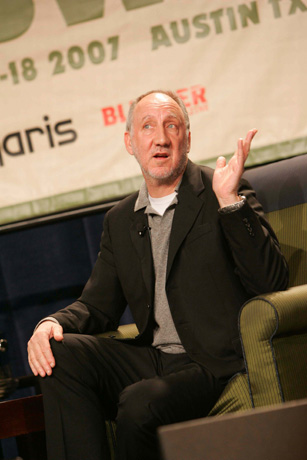 Photo: John Davisson
Photo: John DavissonPete announced his plans for the Lifehouse Method at his keynote speech at SXSW in Austin, Texas on March 14, 2007. Here are excerpts from his discussion.
"I hadn't read this book, but apparently Arthur C. Clark describes something like I describe, which is a grid where everybody gathers for survival in order to communicate and live through entertainment experiences. That was what the Lifehouse was about. So it wasn't quite like the internet, it was a bit like real reality TV. It was a bit like living your life through the lives of others. Vicarious living. Living as a ballet dancer without having to learn ballet. A bit like a kids video game, more like that. But the other side of it was the idea that if everyone was connected, what would they share? What would they share musically, and how would they produce the music that they shared?
"I came up with this idea called the Lifehouse Method, which is a system where you go to a computer, you enter data about yourself, you share some stuff about how you feel, you put a picture up, a photo, and you get back a piece of music. A bit like when a painter paints a portrait, you are the sitter. You just have to sit and keep still. And he paints, or she paints, and you sit. So, the artist is king. Nonetheless, the portrait that is produced is very authentic, because it has been channeled through a great portrait painter. So I thought, this software could be very fabulous, we could do this! In reality, this was 1971. So I got together with Roger Powell, who played with Todd Rundgren, a guy called Tim Souster, who became the composer in residence at Cambridge University, who introduced me to Stockhausen and a few other high brows in modern music, and people from the BBC Radiophonic Workshop. And I realized of course that there was no computer in 1971 big enough or powerful enough to do what I wanted to do. And there was no internet. So of course, everybody that I talked to about this kind of looked at me and went, 'nice idea but I think you are nuts, you should go and get treatment.' That came later [laughs], but it was a huge crash for me.
"I came up with this idea, I thought it would be wonderful, and I had to wait 30 years, for you guys to have computers that are powerful enough to just log onto the internet, and I give you, from April 25 we are launching it in London, a website, and I'm just calling it the Method. I dropped the Lifehouse bit. You come to the website and we give you a piece of music which is yours. Completely unique. In fact, we allow you to own a third of the copyright. So, if Coca Cola decide to use it for their next commercial, you might get rich! The idea is this music is elaborated, and that we take all of this music and bring it together, and play it in a big celebration. Not exactly a festival, but a big event. We gather, we share our music with each other, actually in the flesh, and we see what it sounds like. My idea is that it probably will sound terrible [laughs]. It might sound like the sea, it might sound like a plane going by, it might sound like the gentle undulations of the ocean. It might sound terrible, it might sound beautiful. I don't know."
The Lifehouse Method launch
Pete Townshend held a press conference at Oceanic Studios on April 25, 2007 to announce the launch of the Lifehouse Method system and website. Pete discussed the history of Lifehouse and the details of the Lifehouse Method project. Lawrence Ball presented his portraiture system to the press, and gave a demonstration using John Pidgeon as the test sitter. The visual presentation was run by Rob Lee, and the sophisticated audio system was run by Myles Clarke. Elaborated pieces, including Fragments from The Who’s Endless Wire album, were played back though a myriad speaker system that was set up in the studio. A Q&A session with Pete, Lawrence and John was held at the end.
The following are excerpts from Pete's lecture at the Lifehouse Method launch.
"I'm introducing today something called The Method, which is software, produced by Lawrence Ball, composer, and Dave Snowden, who is a software engineer. It's a website called the Lifehouse Method, which you can go to, to engage, put data in, and get a piece of music out. It's as simple as that.
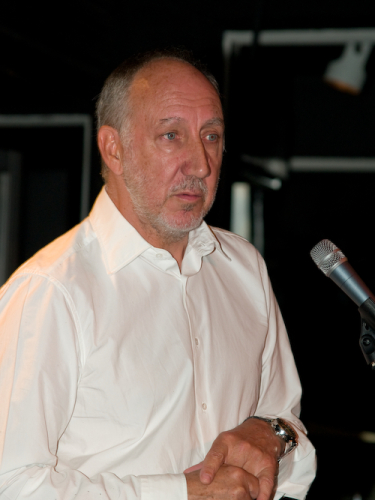 Photo: Ghene Snowdon
Photo: Ghene Snowdon"This is something that I've been dreaming about for a long time. I came up with the idea back in the 70's. I was working on a thing for The Who called Lifehouse, which produced a famous album for The Who called Who's Next. But the idea probably germinated many, many years before. I was at art college in the 60's, taught by a bunch of sharp, forward thinking guys, one in particular called Harold Cohen, who just by chance went on to develop the first robot that paints pictures subjectively. But the course leader was a guy called Roy Ascott, and he described the way that computers of the future would change the way the artist, and I was at art school remember, the artist interfaced and reacted with his or her audience. I think I was one of the students that understood what he was talking about. I don't quite know why, but I suddenly had this vision of the future of computers. It hasn't worked out quite as I imagined of course, but I had a vision. I'm talking about 1961. Computers, there were 3 in the world I think at the time, and one of them was as big as a planet practically. They were huge, and they were cumbersome, and in 1962 I think, the boss of IBM said ‘we think that probably 7 or 8 or a dozen computers will be enough to run the world.’ So the microcomputer we know today wasn’t in the picture, but I had a sense that it would be. I don't quite know why. And then I also had a sense later in the 70's that if you linked computers up it might be useful.
"Now the reason I did this simply was because I am a musician. I understand human interfacing; I understand that when you write a song, people respond to it in their own way. They come from their own place, they make their own decisions, they make their own conclusions. But you as an artist very much respond to the way that they respond to you. Roy Ascott called this ‘feedback’. An early Who trigger word was the word ‘feedback’. In those days it meant the noise that your guitar made when it fed back into the great big Marshall stack behind you. So, a lot of the arty farty ideas that I had at art school started to come into my thesis as a composer, and I was accused very, very often in the world of rock and roll of being pretentious. Who gives a fuck. That's what I am and that's what I do. I was trained at art school, and came from a musical family. But it wasn't so much a pretentiousness, but a hope in a sense that one day we would get to this place. Which is simply that, we've all got computers at home, we've all got a line, I hope, that you can plug your computer into, and you can all speak to one another. You can all share ideas, you can share data.
"The Lifehouse Method, as it is now launched today, is something that allows you to log on, put some data in and get some music out. This isn't a service. It's not like saying to someone, ‘I've got this beautiful golden retriever, and I want a picture of my dog to put on the wall’. And the painter does a picture of the dog and you say you are very happy. This is rather more like saying, ‘I've got this beautiful golden retriever, tell me the truth.’ How would you divine that? You might go deeply inside it, you might take a blood sample, you might do all kinds of things. Different people would do different things. I, as a composer, would try to get something out of this dog that would give me a chance to turn the dog into music. I might listen to the way it breathes, I might touch it and see how it feels, I might listen to its bark, I might look at the rhythm of its running, and so on. So I would gather data about the dog and turn it into [musical] data. This is a portrait. If you go onto the website, you become a sitter. You're in a sense inert. Your role is a part of an artistic process. You become part of a composing machine in which neither me, nor Lawrence, nor Dave, nor you as a sitter are any more important or less important than anyone else. We are all equal, and what comes out at the end is hopefully an authentic reflection or portrait of the data that you put in. So, I like to think of it as musical DNA. The music that comes out of the software, the software has been generated from a musical process which Lawrence Ball created.
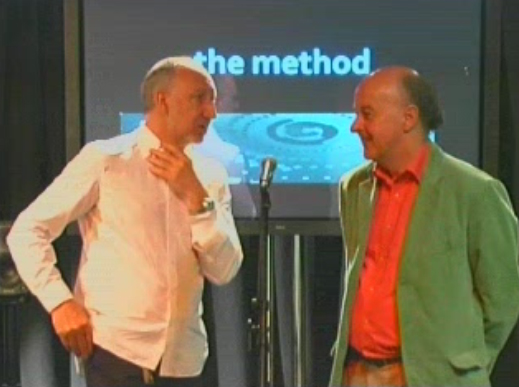 "I first met Lawrence when we were engaged together in a music festival that he does every year called Planet Tree, which is happening here at the moment, or has been for the last few days. It's a new music festival, and Lawrence invited the American composer Terry Riley. I was a big fan of Terry Riley, and in the 70's used Terry Riley and the Indian teacher Meher Baba for one of my first experiments in this particular process. The music that came out of that was called Baba O'Riley, Baba for the Indian teacher and Riley for Terry Riley. Put the two things together and produced a song now which to this day is the one that for some reason, particularly American audiences, go crazy about. I don't know if it's the music or the lyrics, the refrain ‘it's only teenage wasteland’ is the one they love the best. But the ripply sound in the background is the characteristic sound that was produced when I started to program and work as a serious electronic music composer. Lawrence invited Terry over, he did a concert, we met, and then I listened to Lawrence's work and I loved it, I just loved it. So, what is produced by the program is music that is generally music that Lawrence and I tend to like. Whether you like it is absolutely immaterial to us! [laughs] The composer is king in this respect. But what we are trying to do is we are trying to approach the truth from the data we get. And we are trying to produce something that is an authentic compositional reflection of the data that we get put in.
"I first met Lawrence when we were engaged together in a music festival that he does every year called Planet Tree, which is happening here at the moment, or has been for the last few days. It's a new music festival, and Lawrence invited the American composer Terry Riley. I was a big fan of Terry Riley, and in the 70's used Terry Riley and the Indian teacher Meher Baba for one of my first experiments in this particular process. The music that came out of that was called Baba O'Riley, Baba for the Indian teacher and Riley for Terry Riley. Put the two things together and produced a song now which to this day is the one that for some reason, particularly American audiences, go crazy about. I don't know if it's the music or the lyrics, the refrain ‘it's only teenage wasteland’ is the one they love the best. But the ripply sound in the background is the characteristic sound that was produced when I started to program and work as a serious electronic music composer. Lawrence invited Terry over, he did a concert, we met, and then I listened to Lawrence's work and I loved it, I just loved it. So, what is produced by the program is music that is generally music that Lawrence and I tend to like. Whether you like it is absolutely immaterial to us! [laughs] The composer is king in this respect. But what we are trying to do is we are trying to approach the truth from the data we get. And we are trying to produce something that is an authentic compositional reflection of the data that we get put in.
"So simply, you go to a website, you put in some data, you get some music out. And that's it, and all about it. It works, it's simple, and 30 years ago I had this idea that it might be possible, and today I'm delighted to say that from now on, you guys at least if you are here, I think you get a password and username, and you can go give it a try. I would say that when you do try it, try it with an open mind and an open heart because Lawrence is convinced that there is a sense, very much a metaphysical thing that takes place here. I suppose it must be because this ultimately is art. We are talking about reflection, and although data is data is data, you know, paint on a paintbrush is data. If you do it in good heart you tend to get a different kind of result than if you do it kinda ‘go on, prove it to me that this is going to be good’ and you may not like what comes out. So give it a few tries and see how you get along.
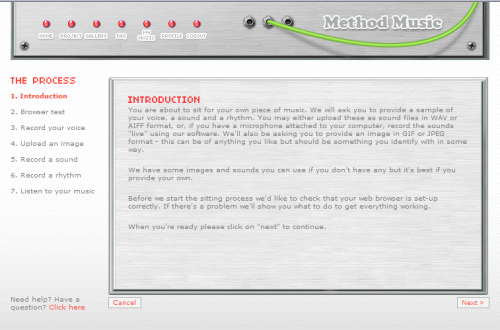
"I've worked on a few elaborations. We can elaborate the information that is produced in the first pass on the computer. And the way that we do this is presentationally, we improve the sounds, we improve the arrangement to some extent, we can thin out the boring bits and just keep in the good bits. In a way, you'll all be familiar with this as journalists, this is the editorial process. Subsequently we can go even further, which is we can elaborate pieces of music by varying them, by adding lyrics, by reengaging with the sitter. In other words, giving certain sitters a chance to come back and have another go. This is the future.
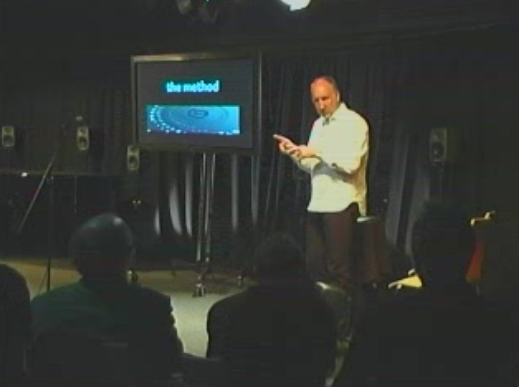 "What [Lawrence] has done is divided the parts up so that we are using an electronic music multi speaker system as well. I call this a myriad speaker system. When I first worked on the Lifehouse story, Tim Souster, who was then an electronic musician, he went on to be the composer in residence at Cambridge so he got quite posh, but he introduced me to Stockhausen when he was doing a BBC performance. I remember asking him about when he did his compositions why he used loads of different speakers, and he said it was to create what you get with an orchestra, which is for example if you all began to sing, you actually have a space which is not just stereo, it's a field of sound. So in a sense it's to try and create a field of sound from instruments and sounds that are essentially electronic to make it sound more like an orchestra. It's a bit of a cheat. We have talked about how delightful it would be, how extraordinary it would be, and again it’s something modern computers allow us to do, which is to take this data that we have - remember data is musical data - we can print sheet music really quite easily, and immediately put that sheet music in front of skilled musicians, and they can play it. All that's happening here is this data is being played by electronic instruments. We could hire an orchestra and churn this music out, and instead of hearing it played by synthesizers, you could hear it played by musicians. How great that would be. That's something we may do further down the line. We'll give it a try.
"What [Lawrence] has done is divided the parts up so that we are using an electronic music multi speaker system as well. I call this a myriad speaker system. When I first worked on the Lifehouse story, Tim Souster, who was then an electronic musician, he went on to be the composer in residence at Cambridge so he got quite posh, but he introduced me to Stockhausen when he was doing a BBC performance. I remember asking him about when he did his compositions why he used loads of different speakers, and he said it was to create what you get with an orchestra, which is for example if you all began to sing, you actually have a space which is not just stereo, it's a field of sound. So in a sense it's to try and create a field of sound from instruments and sounds that are essentially electronic to make it sound more like an orchestra. It's a bit of a cheat. We have talked about how delightful it would be, how extraordinary it would be, and again it’s something modern computers allow us to do, which is to take this data that we have - remember data is musical data - we can print sheet music really quite easily, and immediately put that sheet music in front of skilled musicians, and they can play it. All that's happening here is this data is being played by electronic instruments. We could hire an orchestra and churn this music out, and instead of hearing it played by synthesizers, you could hear it played by musicians. How great that would be. That's something we may do further down the line. We'll give it a try.
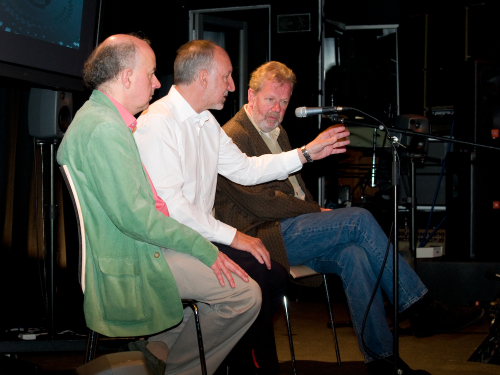 Photo: Ghene Snowdon
Photo: Ghene Snowdon"In your press pack you will have a copy of and you can listen to the Meher Baba piece. If you listen to that, you will hear the raw material that I worked with to produce [Fragments], and I did a lot of things that are very obvious. I listened to the whole thing, which is a 5 minute piece, and I picked pieces, chunks of it. Firstly I discovered that the cycle was not an 8 bar, or a 4 bar, or a 16 bar cycle, it was 15 bars. So, every now and then you hear a little drum flange, which kind of adds the bar on what became a 12 bar cycle. I would take chunks that I liked the sound of, that felt to me fairly simple, but also to create the conventional ‘introduction - verse - chorus - verse - chorus - middle bit - verse - chorus – end’ that we are so used to in the current tradition of pop writing, at least conventional pop writing, the kind that I grew up with, and create a frame for it and then elaborate it. And you can hear to some extent that some of the lyrics are inspired directly by the sounds. For example, when I talk about snowflakes falling, the sounds felt to me like snowflakes falling, so I simply came up with that idea. The idea that we are fragments, we are pieces, we are coming together, this was a notion that came out of listening to many, many hours of Method music and thinking, ‘what does this feel like?’
"Lawrence mentioned that you can take two pieces and put them together. I would like to go further and to try something of a much higher order of celebration, where we all gather and everybody in a years time or two years time, when we've had enough input here, to all gather, to share what we have done together, and to just celebrate in the flesh and see how it all feels. And hear a piece of music, and up comes your picture, and you go, ‘Oh my god that's me!’"
The Method portrait and elaboration
Pete Townshend was officially the first sitter to test out the Lifehouse Method system, after Lawrence Ball and Dave Snowdon completed their implementation and testing. The following tracks are Pete’s first original portrait taken in August 2006, and the version that Lawrence Ball elaborated using Reason - an integrated sequencer/synthesizer - in November 2006.
Method Music
Lawrence Ball released Method Music in 2012, a 2-CD set of music that was originally generated as sample pieces designed to demonstrate to Pete how the sitter portraits output by the Lifehouse Method portraiture system could sound. These Imaginary Sitter pieces were elaborated with the help of Pete Townshend’s studio engineer, Myles Clarke, who created high quality instrumentation for the midi patterns, which were played back and recorded through a “myriad sound system” designed to separate each instrument out through individual speakers in order to give each voice a distinct and individual character. The results are astounding, and the music featured on Method Music is rich and stunningly beautiful.
"Method Music evolved from Pete Townshend’s question to me about generating unique pieces of music from the input of personal characteristics as data, a question related closely to his ongoing project Lifehouse. I wanted to see what the music could sound like prior to designing the proposed system of portraiture, and I created the tracks on Disc One, Imaginary Sitters, as a touchstone towards designing the software which would eventually execute the task itself. I generated and then selected melodic streams, which were then woven together on computer with a sequencer. This is a part-programming and part-editing job, but it begins with imagining and developing patterns of notes, often cascading canons with intricate phase changes.
"Disc Two, Imaginary Galaxies, is meditative and mostly orchestral music, evolved from Imaginary Sitters and also from earlier pieces of mine such as ‘Crystal Mists In Silver Air’ (1994) and ‘Silver Stream’ (1985). These pieces use very slow tempi, and the unusual combination of slow, steady development and structure with floating sounds; the Galaxies have the same 10 segment structure as the Sitters, but are much slower.
"Work on Method Music was done primarily at Pete Townshend’s Oceanic Studios in Twickenham using a sophisticated array of samples and speakers (36 speakers, to be exact)." Lawrence Ball - Method Music liner notes
For more information, please visit the Method Music website.
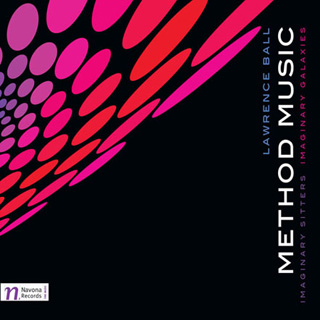
Track list
01 Imaginary Sitters: Meher Baba Piece
02 Imaginary Sitters: Sitter No. 9
03 Imaginary Sitters: Sitter No. 10
04 Imaginary Sitters: Victoria
05 Imaginary Sitters: Sitter No. 11
06 Imaginary Sitters: Sitter No. 12
07 Imaginary Sitters: Sitter No. 13
08 Imaginary Sitters: Sitter No. 14
09 Imaginary Sitters: Sitter No. 15
10 Imaginary Sitters: Sitter No. 17
11 Imaginary Sitters: Sitter No. 16
01 Imaginary Galaxies: Galaxy No. 1 (for the late Syd Barrett)
02 Imaginary Galaxies: Galaxy No. 2 (for tha late Hugh Hopper)
03 Imaginary Galaxies: Galaxy No. 3 (for the late Gyorgy Ligeti)
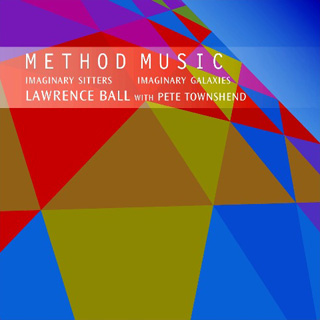
Credits
Lawrence Ball: Composer, Programmer, and Discoverer of Harmonic Mathematics (1983)
Pete Townshend: Conceiver (1971) and Producer of Method Music
Bob Lord: Producer
Myles Clarke: Co-Producer and Engineer
Dave Snowdon: Developer of Harmonic Mathematics (1993), Designer and Engineer of the Method web system (2004)
Richard Evans: Original Design and Art Direction (iTunes release)
Leeann Leftwich Zajas: Art Director / Product Designer (CD release)
Label: Navona Records
Release Date: January 31, 2012
Recorded at: Oceanic Studios, Twickenham, London
Interview with Lawrence Ball - January 2014
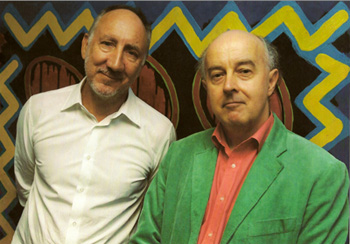 Lawrence Ball is an innovative composer, a musician-philosopher who pushes the boundaries of what music can do or be. He has composed for orchestra, dance, film and choir. He has created a new medium Speak-Sing-Play where poetry is heard spoken, sung, and accompanied simultaneously. Since 2001 Lawrence has worked with sarod player Lisa Sangita Moskow and vocalist Manickam Yogeswaran on improvised music based on North and South Indian raga scales. He has created 6 multi-media audio-visual installations with the artist Genie Poretsky-Lee, including Anonymous Words (2007) and Image Of Sound (2008). In 1996 he founded Planet Tree Music Festival which he also directs. Ball is a pioneer in music, having addressed meditative and healing presence and state-of-mind, primarily, for over 35 years.
Lawrence Ball is an innovative composer, a musician-philosopher who pushes the boundaries of what music can do or be. He has composed for orchestra, dance, film and choir. He has created a new medium Speak-Sing-Play where poetry is heard spoken, sung, and accompanied simultaneously. Since 2001 Lawrence has worked with sarod player Lisa Sangita Moskow and vocalist Manickam Yogeswaran on improvised music based on North and South Indian raga scales. He has created 6 multi-media audio-visual installations with the artist Genie Poretsky-Lee, including Anonymous Words (2007) and Image Of Sound (2008). In 1996 he founded Planet Tree Music Festival which he also directs. Ball is a pioneer in music, having addressed meditative and healing presence and state-of-mind, primarily, for over 35 years.
For more information about Lawrence and the work he did on the Method project, please visit his blog at meditationalmusic.net/blog/category/methodmusic/
When did you first become acquainted with Pete Townshend, and how did you become involved with the Lifehouse Method project?
I approached him about funding Planet Tree Music Festival in 1998, when I featured a Terry Riley solo concert, which he did do. Then we emailed back and forth about the relation between music, computers and consciousness. In 2003, he called me and asked if I could generate music from people's data. I said yes immediately. It took the portraiture project a while to warm up, and there were 3 strands to the work.
- The portraiture system
- My album which grew out of sketches for the Sitters' music
- Fragments, which Pete built out of "Meher Baba Piece" on Method Music album, which itself is on the Who's album "Endless Wire"
What was it like to work with Pete on something as technically and creatively innovative as this project? Can you describe his involvement, and how you were able to collaborate on ideas?
We had periodic long meetings, sometimes gloriously off topic, which were very enjoyable. I had my friend and collaborator Dave Snowdon involved although he took time to settle his role in, and approach to, the project. Pete is a seasoned high energy artist, I found him kind and very enthusiastic, but occasionally I got rather singed energy wise. Which was OK. He applied comparable levels of sound quality to my album to those he is used to, which stretched my impatience to complete the work. In retrospect I'm very glad he did. The scope of the project was somewhat daunting, the programme needed to be able to produce millions of distinct pieces, which I managed, although so far only 10,500 have been created.
How was Pete’s original vision of “The Method” first described to you? What was your approach to making his dream a reality?
In a phone call in Nov 2003, Pete described to me the idea to generate "music from a person's data", in a simple, entertaining, possibly fractal, without a huge team of programmers, way. Baba O'Riley was cited (it was Terry Riley and our in common love of his music, especially "A Rainbow In Curved Air" (Pete had bought 30 copies) that brought Pete and I together for the 1998 festival appearance by Terry), and it was a landmark call.
Can you describe the difference between the synthesizer systems used by Pete Townshend and Terry Riley to create early cyclical electronic music, and the computer generated Lifehouse Method system that you helped to create? Were you able to incorporate any of the concepts of the original system into your new one in order to recreate a similar soundscape?
Baba O'Riley's paradiddle was made with a Lowrie organ, and the final loop taken from a longer "generation session" of sounds. Terry's bubbling firmament of sound on "A Rainbow In Curved Air" was created on one of the first studio multi-track reel-to-reel tape recorders, using tape speeds and echo to make rapid fluctuating figures with many different electronic keyboards. This was done manually, despite the speed change trickery. I of course, in 2003-2007, used MIDI. I wrote software that Dave replicated for the Lifehouse-Method portraiture that could generate related patterns with a wide variety of speeds and shapes, using my harmonic maths, developed mostly in the 1980s, that could generate melodic vortices changing gradually in fascinating ways. Similar target, but more contemporary means.
What did Pete believe the nature of a musical portrait should be, and what did he think an authentic portrait should sound like?
This was left to me largely, but Pete emphasised that artists often remove much imagery over and over before settling for the result they want.
What are Harmonic Mathematics, and how were you able to use them for this project?
I developed, out of the base of computer filmmaker John Whitney's "Differential Dynamics", and with the help of friends and students, a new kind of mathematics that generates beautiful patterns that dissolve and recrystallise continually. See my youtube video helix for a good visual representation of HM. From the experience of creating the "Number Rays" series of pieces in the 80s, I was able to create midi HM generation for the album, and realise the music with different HM melody streams through different instruments on synthesizer. Inspired by John Whitney's pre-computer and computer films, Michael Tusch and myself developed harmonic mathematics on the shoulders of his concept "differential dynamics" - and this was applied to graphic visuals, sound timbres and melodic loops that evolved, in the 80s. Dave Snowdon, with this input, developed a programme in 1995 called Visual Harmony, which embodies and further extends this work in the graphics area. This has and is being used as a live performance tool at musical events. Dave Snowdon has a website about this at visualharmony.org.
How were you able to create the Imaginary Sitters, such as the Meher Baba Piece that was eventually used in the song Fragments on The Who’s album Endless Wire?
By loading DNA like strands of HM melody, and cascading canons of melody, into a sequencer, and manually shaping large orchestrations of them to taste. See product notes section at navonarecords.com/methodmusic, where the album creation process is laid out.
How close did the system that Dave Snowdon programmed resemble your initial design? Did you have to make any major modifications to your plans in order to enable it to work in the real world?
There were many enhancements I had in the pipeline, some of which I used on the album, such as harmonic mathematical cascading canons, and some percussion part improvements, that never managed to get implemented by Dave, largely due to the pressure he worked under to get the more internet end of the programme working in a way to service the request traffic, and traffic quantity, for portraits that were considered likely. To his credit, the system never crashed, even when under heavy usage. So exact, but sadly not as complete as I'd hoped.
How were you able to elaborate the computer generated portraits to get such a rich and high quality sound for the Method Music album?
The album was not from portraits, these were sitters in the imagination, a touchstone set so that Pete and I could get a feel for what the portraits OUGHT to sound like. The Meher Baba piece however on my album was elaborated by Pete as "Fragments" on the Who's album Endless Wire.
How involved was Pete in the production of the Method Music album?
He listened to everything, and enthused greatly, clearly loved what I was doing. Then when I had completed an album's worth of material, he suggested we set about really shining up the sound big time. He made many suggestions, resulting in my re-recording the album the equivalent of three times: first to get better samples and sound, then to use a midi-controlled pianola in his home studio for all the piano parts, then to rerecord all the drum parts with partially pitched tones to add a melodic flavour to all the drumkit sounds, then to putting each instrument through a separate high quality monitor speaker to help the sounds really speak distinctly in the studio space, then he removed the stage at Oceanic as it sounded too boxy, and then Myles and I swung some of the monitors as pendulums to give a great phasing effect. A very ambitious recording.
Interview with Dave Snowdon - January 2014
Dave Snowdon was formerly a research scientist at Xerox Research Centre Europe in Grenoble, France where he created innovative systems for information sharing and worked with peer to peer and context-driven mobile systems. After Xerox, he co-founded Snowtiger Design, a small web/software consultancy, where he put a decade worth of personal experience in professional software development to work for his clients. While at Snowtiger he wrote the software and web user interface for Pete Townshend’s Lifehouse Method - a system to generate unique pieces of music for each individual user. Dave is currently a staff engineer at VMware, based in London.
Please visit Dave's website at davesnowdon.com/project/lifehousemethod to view details of the Lifehouse Method system and screen shots of the website.
How did you become involved in the Lifehouse Method project?
It was thanks to Lawrence that I got involved in the project. Lawrence and I had collaborated for many years to produce software to generate dynamic graphics based on Lawrence's system of harmonic maths. When Pete asked Lawrence if he knew anyone who could write the software to implement Pete's vision for The Method Lawrence recommended me.
How involved was Pete Townshend in the software development of the Lifehouse Method site? Did he work with you on the various stages of production and make any suggestions along the way?
Lawrence and I would send Pete examples as the project progressed and get his feedback. Pete also gave feedback on the design of the web interface, choice of instruments, sounds that users could select etc. Generally, Pete gave feedback when it would be helpful but did not try to micro-manage what Lawrence and I were doing.
Did you receive any particular brief from Pete or Lawrence that created a challenge for you to technically implement in the program?
There were several aspects that were challenging:
- Working out how to generate pleasing music from the inputs provided by the "sitters" (as Pete called people using the software). We had to accept a voice sample, a sound, an image and a rhythm and turn this into music even if the sitters were not themselves musically gifted. This meant that we could not directly use the sounds and rhythms that people submitted and instead had to process the files and extract information about the sort of sound, rhythm and image a person had submitted. We then used an expert system to convert the thousands of numeric values to a set of parameters used to drive a composition engine that I wrote based on Lawrence's principles of harmonic maths.
- Generating good quality audio - this meant that we could not rely on the sound cards in people's computers and had to generate MP3 audio files on the server. This was actually the most computationally intensive part of the software.
- We needed to give "sitters" the ability to record a sound and send it to a server using only software on the web. This was before the days of HTML5 and we couldn't use Flash since the Adobe server software required was expensive and not a good fit with the rest of the system. In the end we wrote a java applet to record the audio and send it to the server.
How close did you come to recreating Pete’s 1970’s vision of Lifehouse? Was there anything that he dreamt of doing back then that was still not possible to implement today?
I think we came pretty close to recreating the vision. To my knowledge there wasn't anything significant that Pete felt we were missing.
How did you go about analyzing the data that was input by the sitter? Can you briefly explain the process that you used to convert the images and sounds into method music?
There were several stages in processing the data. As I mentioned above we first needed to do various types of signal processing to extract information about the inputs (for example the frequencies in the sounds, the variations in colours used in the image, the complexity of the image, the regularity of the rhythm provided and so on). This generated several thousand unique values. This data was then fed into an expert system that decided on the hundreds of music parameters used to compose the music. These parameters were fed to a custom written composition engine which generated MIDI data. The MIDI data was then processed by a software synthesizer to generate an audio file which was then converted to an MP3 file which was stored on the web site and made available to the sitter to play or download.
Did you place any emphasis on any particular input? For example, did the rhythm input have a heavier weight than the photo, or did all the inputs have equal weight?
As I recall they were all equally weighted.
How did you go about linking the song segments together? Was there a random factor as to which order these segments were placed, or was it specific based on the input?
We didn't make use of random values, as I recall everything was decided based on the data generated from the inputs provided by the sitter.
Was there anything more that you planned to implement, such as visual output, that you were unable to do? If given the opportunity, would you like to expand on the features some day?
As mentioned on davesnowdon.com/project/lifehousemethod there were several things I would have liked to have done.
- The ability for people to allow others to listen to their music
- A flickr-like way for people to comment on music
- A way to see & hear the inputs used to create a piece of music and to see a representation of how lifehouse-method.com saw those same inputs (ie. a visualisation of the data extracted from them).
Now with cloud computing it would be practical to dynamically adapt the number of servers used to run the site according to how busy the site was - this would make it far more cost effective to run the Lifehouse Method software today than it was back in 2007.
Interview with Myles Clarke - February 2014
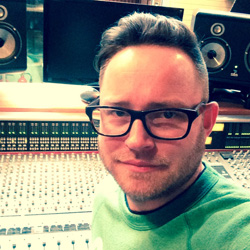
Tell me about your involvement in working on the Lifehouse Method project. How was it collaborating with Pete and Lawrence on this?
Initially my role was to help create a sound-palette that would work with the Lifehouse-Method website that Lawrence and Dave Snowdon were working on. In 2005 there were a reasonable amount of ‘General Midi’ standard software sound modules that could have been used, but I think the general consensus was that they sounded a bit ‘too’ standardised. We also felt that the note data generated by the Method software, often very pacey and dense, sometimes sounded a bit cloudy or mushy. The aim was to create a more bespoke collection of instruments that would act more effectively together, whatever the Method software threw at it. We collected and tweaked sounds from a wide selection of existing sound modules, sample libraries, synthesisers and also sampled our own. We then organised them down into a fairly unusual online playback file format, which could be used within the online program. I found the collaboration of ideas, computer programming, mathematics and audio technology satisfyingly nerdy, interesting and enjoyable.
How did you go about producing the Method album? What was your process for adding such high quality instrumentation to the Portraits?
As I said, I was initially tasked with creating a collection of sounds that would work across the massive variation created by the Method within the online experience. When it came to producing the album we had the opportunity to tweak, improve, or even completely change the sounds to suit the individual Musical Portrait. We’d begin by listening carefully to the online generated output, we’d then listen to the same note data being sent through other sources in the studio. As we worked through each piece, we began to build a sort of ‘Mark2’ sound palette that was more editable, depending on the feel and density of music generated. For example, we were able to change the way a sound reacted to MIDI parameters such as Velocity (the ‘force’ of the note), or were able to control the attack and release times of the sounds (particularly useful with String and Brass sounds).
I remember we spent quite a lot of time with the Drums. The Method rarely spat out anything that really resembled ‘familiar’ drum patterns that we are all used to. We could have cheated here and changed the note data to create more familiar patterns, but that wouldn’t really have been in the spirit of the Method. If you DO put a nice chunky, familiar drum pattern under any of the Portraits, you almost always get a really useable backing track. That’s part of what Pete did with FRAGMENTS.
What we ended up doing with the Drums on the Method Album, was to make them even more ‘out-there’ by applying the Harmonic Maths to the pitch of the drums. From what I remember, we created a massive drum kit program where a resonant filter ‘barked’ out accordingly. So we had 8 Kick drums, each resonating its own note, the same for Snare, Tom Toms, etc. The result was very weird if programmed a lå Pop music, but with the Method data we used this ‘tuned drum kit’ lower in the mix to add percussive, harmonic texture, rather than it being a leading element.
The use of a Yamaha Disklavier was particularly effective with pieces that included Piano; we were able to send note data to a real piano (which uses solenoids under each key) and recorded it in a traditional manor. This really helped to glue those pieces together - In fact, the ideal solution to have brought the Method to life would have been to have a completely robotic orchestra… Instead, Pete suggested we ‘put the orchestra into a space’ by using a system that he calls a ‘Myriad’ of speakers.
How did the myriad speaker system work, and how did you use this to record the album?
If you imagine a group of musicians on a stage, or in a studio, where each musician/instrument has been replaced by a loudspeaker, that’s the basis of the set-up. For each Portrait we drew a ‘map’ of where each instrument would be placed if we were working with a real group, and sent the sound to the corresponding speaker set up on the studio floor. (That’s a very basic way of explaining it, sometimes we might position an instrument between two speakers, or feed some low frequency to various sub-woofers within the system, sometimes we’d pan gently between speakers to give a feeling of movement…) Speakers were placed low, middle, high, pointing forwards or backwards, depending on how it sounded through the microphone. We learnt with trial and error as we progressed through the pieces.
The sound in the room was captured with a single microphone. This was to give a natural coherent feel to the sound in the room, coming out of the speakers. The Soundfield microphone uses capsules fixed in a very precise tetrahedral shape that, when processed accordingly, gives a very accurate reproduction of the sound in a room. This can be processed to give true stereo or 5.1 surround sound, depending on your needs. For the Method, intended for CD/Online release, we used the Stereo recordings as masters.
Did you encounter any technical challenges setting up the sound system for the launch presentation?
With an experimental project like this, it usually feels like one technical challenge after another - once one is solved, another crops up. There was certainly a lot of quick thinking and problem solving. But I don’t think there were many problems that we couldn’t overcome one way or another. The only frustration I remember having was working out ways to overcome the speaker sound-colouring that accumulated as more material was played through more speakers. The Genelec speakers were chosen because they were inherently fairly colourless (the ‘colour’ is a slight ‘honk or bark’ that most speakers have, if you switch from any one pair of speakers to another pair, you will hear the difference). We found that these frequencies could become quite extreme when there were 32 speakers playing music simultaneously. With some sounds I had to change the sound being sent TO the speakers considerably to calm down the sound in the room.
Did you learn any new recording techniques from the Lifehouse Method that you have incorporated into other studio projects?
Not specific techniques as such, but from my side of things the project was very reliant on working out and honing processes to make repetitive tasks as painless and speedy as possible with large quantities of data. I’ve certainly found that since then I’m fairly unfazed by ideas that might have formerly been overwhelming. For example, I’d often thought about emphasising resonances within percussive sounds prior to the project, but I’d never had a reason to use the brainpower needed to create a ‘tuned drum kit’ before. Since then I’ve used some (more subtle) elements of ‘tuned drums’ on various projects.
Do you know if there are any similarities between the Lifehouse Method and Floss, such as recording processes or soundscapes?
Not as yet. Time will tell.
Interview with Richard Evans - March 2014
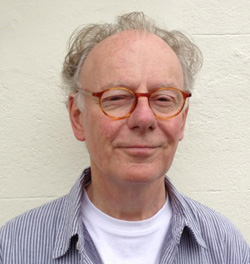 Richard Evans' association with The Who goes back nearly forty years to when he first photographed Keith Moon naked on a hotel room sofa for the centre-fold of Bellboy, the tour programme for the Who Put the Boot In gigs. Since then he has worked continuously with the band, designing pretty much everything including countless album covers, programmes, posters, badges and buttons, stickers, t-shirts, tour logos, back stage passes, even the web site – you name it, he's probably designed it. Related design work includes solo projects for both Pete Townshend and Roger Daltrey.
Richard Evans' association with The Who goes back nearly forty years to when he first photographed Keith Moon naked on a hotel room sofa for the centre-fold of Bellboy, the tour programme for the Who Put the Boot In gigs. Since then he has worked continuously with the band, designing pretty much everything including countless album covers, programmes, posters, badges and buttons, stickers, t-shirts, tour logos, back stage passes, even the web site – you name it, he's probably designed it. Related design work includes solo projects for both Pete Townshend and Roger Daltrey.
For more information about Richard Evans and to view his impressive artwork, please visit rdevans.com.
How did you come to be involved with creating the artwork for The Method? Did you receive any particular brief from Pete or Lawrence for this?
Lawrence's Method album came as a sort of follow-on to The Who's Endless Wire album. Pete launched the Method site where you could feed your information in and wait five minutes and out popped a piece of music that was YOU and you alone. I had done this about three times and was quite intrigued by it all. It was like listening to your own body's engine ticking over. I met Lawrence when I was doing the final artwork for Endless Wire and he showed me what the Visual Harmony software, which he and Dave Snowdon had developed, could do. I just sat at his computer monitor and watched all the endless and colourful possibilities swirl away in front of me. Again, intriguing stuff.
I should think the only brief that I got was from Lawrence in that he wanted the album cover to reflect what the music within was all about. Now that, of course, is the basic brief of any album cover. I had a wealth of material that I had gathered from the Visual Harmony software and I took some of that as my starting-off point. I narrowed my designs down to two or three and showed them to Lawrence and Pete and they chose the one that was used. My second favourite concept was used in the digital booklet and was also used for the launch invite. That's the swirling red and orange spiral against royal blue you see here on this page.
How different was this project from previous artwork that you have done for Pete and The Who?
No different at all really inasmuch as it, like Endless Wire, was a new album and therefore you like to come up with an innovative concept that says in pictures what the music contained therein is all about.
What all was involved in utilizing Harmonic Mathematics as a basis for your designs? Did you have to change your typical design approach due to the technical aspects involved?
I'll talk more about that in the following question relating to Endless Wire but on a purely technical note, it may have been very advanced software but even in 2006/2007 there were still very basic problems to overcome starting with the fact that Dave and Lawrence were PC people and I am a die-hard Apple Mac man and rarely do the two meet compatibly – the platforms I mean, not the men! The two of them had managed to produce a Mac version but unfortunately it was only for OS 9 whereas I was already on OS X so their software didn't work on my Mac. In the end I had to use the software on Lawrence's PC.
Basically once the software is up and running it's just one mass of swirling shapes, blocks, liquid blobs, and discs flying through the blackness of space – sort of like a giant sophisticated lava lamp being operated by some crazed mad man on a trip! With the software you can steer your path through these shapes and turn and reverse and see them from a completely different angle. As I was doing this I was taking screen grabs of bits that I really liked. After ten minutes or so I had dozens of screen grabs, all really beautiful and all very useable.
Back home on my Mac I went through them and selected my favourites. Now, the trouble with screen grabs is that they are very low resolution (72 dots per inch) and I needed the images to be a much higher quality for print (300dpi). So once I had chosen the ones I was going to use I re-drew each and every blob and block in high resolution. I then tweaked and adjusted some of the colours and added saturation where it was needed.
You also used Harmonic Mathematics for creating The Who’s Endless Wire album cover. Can you tell us a little about your work for that?
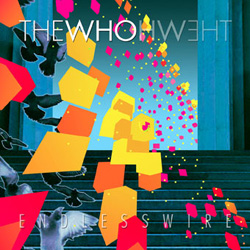 The concept that Pete chose for the cover of Endless Wire was pretty much what you see, but without the blizzard of blocks of colour. The original idea came from the lyrics to 'Mirror Door' and I had squares (album covers?) of the various artists mentioned in the lyrics flying up through the pillars and down the steps. I have always had a fondness for maelstroms, blizzards and hurricanes where you see people's possessions hurtling through the air. Think of the end of the movie, Zabriskie Point with the house exploding in slow motion to the music of Pink Floyd. We did lots of things like this in my time working with Po and Storm at Hipgnosis – stuff coming over the horizon, flying saucers, spacey Syd Barrett-type things. In 1989 I did a cover with Po for Deep Purple called Nobody's Perfect where I had imperfect objects flying across an Arizona landscape in one long arc – things such as a square peg in a round hole, a bearded circus lady, a nine shilling note, black tulips, that sort of thing.
The concept that Pete chose for the cover of Endless Wire was pretty much what you see, but without the blizzard of blocks of colour. The original idea came from the lyrics to 'Mirror Door' and I had squares (album covers?) of the various artists mentioned in the lyrics flying up through the pillars and down the steps. I have always had a fondness for maelstroms, blizzards and hurricanes where you see people's possessions hurtling through the air. Think of the end of the movie, Zabriskie Point with the house exploding in slow motion to the music of Pink Floyd. We did lots of things like this in my time working with Po and Storm at Hipgnosis – stuff coming over the horizon, flying saucers, spacey Syd Barrett-type things. In 1989 I did a cover with Po for Deep Purple called Nobody's Perfect where I had imperfect objects flying across an Arizona landscape in one long arc – things such as a square peg in a round hole, a bearded circus lady, a nine shilling note, black tulips, that sort of thing.
So with Endless Wire I had pictures of all the people who had passed through the Mirror Door – Howlin' Wolf and old Link Wray, Bobby Darin, Brownie McGhee, Elvis, Buddy and Eddie C. In March 2006, when I showed the concept to Pete, I said "Pete, You can't have Doris Day in here. She's still alive. She's on this side of the door!" Pete thought she had already passed away, I think. Anyway, Doris Day rhymed very nicely with 'old Link Wray' so she stayed in. It was at this moment that Pete told me about Visual Harmony and Lawrence Ball and he played me a snippet of what was to become 'Fragments'. Once I had seen what the software could do it was a simple choice to replace the faces with the 'barrage of coloured bits'. It was less obvious than the faces and more intriguing. But, as with Method Music, I had to re-draw each and every damn block of colour. No wonder I went for a simpler design for Method Music!
The white psychedelic doves or 'angels', incidentally, came from a part of Pete's original working script and the story boards for The Boy Who Heard Music – from which came the mini-opera Wire & Glass (originally titled The Glass Household). For the steps and pillars, which, in the story, Ray High climbs as the angels circle overhead and jewels and gold hurtle down, I looked, and was inspired by images of the Lincoln Memorial and the seated figure of Lincoln at the top of the shallow steps. I love the majesty of that view point, looking up the steps to the pillars.
Have you learned any new techniques from this project that inspired new ways to design graphics?
I've always had a love of strong, vibrant colours, especially when they are set against black or a warm dark grey and that is reflected in the rest of the Endless Wire and Method Music packages. When Navona Records came to release the CD version of the album I sent them my imagery that I had collected from the Visual Harmony software and they used another of my images which looks great. I didn't really learn any new techniques per se, but it was great fun using the Visual Harmony software and then taking it a step further.
The future of Lifehouse Method
"Since the closing of the Lifehouse Method site there has been much speculation as to the fate of the music generated, the possibility of re-opening a new, revised Method site, the staging of a Method concert for large live ensembles, and various other ideas affiliated with Lifehouse. While I can say nothing specific regarding those potentialities (or eventualities), the fact remains that Lifehouse, despite my best attempts, is a book that simply will not let itself be closed. That there is more to come is inevitable; what form it takes remains to be seen.” Pete Townshend - Method Music liner notes
Credits
Produced, researched and written by Carrie Pratt
Many thanks to Lawrence Ball, Dave Snowdon, Myles Clarke, Richard Evans, and Ghene Snowdon for all their help and additional references.
